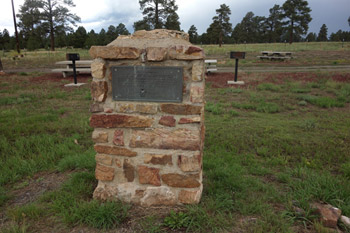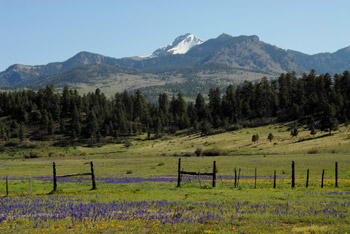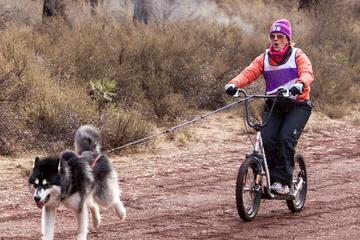
Pagaso Springs, Colorado
by Karin Leperi
Albert H. Pfeiffer, a European immigrant and a comrade of Kit Carson, was a fur trapper, pioneer, soldier, and Indian agent, born in Germany on October 7, 1822. He was the son of a Lutheran minister from Friesland while his mother allegedly was a descendent of Scottish royalty. As such, young Pfeiffer was enrolled in the Military Academy of Stockholm, known for its excellence in military strategy. At the age of twenty-two, he immigrated to America, settling in St. Louis, Missouri in 1844. Seeking a more western experience, he moved on to Santa Fe, New Mexico Territory.
By the age of thirty-four, he married into an influential Mexican family from Abiquiu. It was rumored that his sweetheart and new bride Antonita, wore one of the most expensive wedding dresses for the time.
A few years later, Pfeiffer became a sub-agent when Abiquiu was a trading post. He reported to Indian agent Christopher “Kit” Carson. By all accounts, Pfeiffer maintained friendly relations with the San Juan Utes, more so than any other white man had before him. Reputedly, he was such a close friend of Chief Ouray that he was adopted by the tribe. The mutual reverence would continue throughout his life.
Then came the Civil War. Pfeiffer enlisted with the New Mexico Volunteers, serving under Colonel Kit Carson. He would eventually be promoted to 1st lieutenant, captain, and then colonel. Fighting mostly against the Indians, the two forged a friendship that would continue throughout their lives. According to Pfeiffer’s granddaughter Pauline Nielsen, “Recordings in military archives place him constantly by Carson’s side riding together from the start of his career. He was twenty years younger than Kit Carson, but history and writings tell of the close friendship that grew between the two. The relationship was a genuine one of man to man and officer to officer.”
Avenging the Heart
 Pfeiffer had a penchant for fighting in the nude, or so it would seem. His first nude encounter happened on June 20, 1863, as a forty-one year-old captain based at Fort McRae, near today’s Truth or Consequences, New Mexico. (The fort has since been flooded by Elephant Butte Reservoir). The captain had taken ill and thought the hot springs, about six miles from the fort near the Rio Grande River, would be beneficial for his malady. He bathed in the curative springs, while his pregnant wife of seven years, Antonita, his adopted daughter Maria, and her attendant Mrs. Mercardo, bathed in a pool nearby. His three-year old son Albert had been left at the fort with servants. Additionally, soldiers accompanied the group to safeguard their bathing at El Ojo del Muerto, the Spring of the Dead.
Pfeiffer had a penchant for fighting in the nude, or so it would seem. His first nude encounter happened on June 20, 1863, as a forty-one year-old captain based at Fort McRae, near today’s Truth or Consequences, New Mexico. (The fort has since been flooded by Elephant Butte Reservoir). The captain had taken ill and thought the hot springs, about six miles from the fort near the Rio Grande River, would be beneficial for his malady. He bathed in the curative springs, while his pregnant wife of seven years, Antonita, his adopted daughter Maria, and her attendant Mrs. Mercardo, bathed in a pool nearby. His three-year old son Albert had been left at the fort with servants. Additionally, soldiers accompanied the group to safeguard their bathing at El Ojo del Muerto, the Spring of the Dead.
Unknown to them, about twenty Mescalero Apache lie in wait, carefully concealed by rocks, waiting for the right moment. The Apache ambushed the party, snatching Pfeiffer’s wife, daughter, and attendant. Separated from Captain Pfeiffer by the Apaches, the soldiers quickly dispersed, leaving Pfeiffer to fend for himself.
 Pfeiffer’s only thoughts were to save his wife and daughter. With his rifle lying close by, he instinctively leapt for the rifle, running to the safety of the nearby river bank, completely nude. Clothes were the least of his concern. According to the November 1933 issue of The Colorado Magazine, “He was followed by the Indians who shot at him, one of the arrows entering his back with the end coming out in front. In this condition, with the arrow in his back, he ran until he reached an enclosure of rock where he made a halt to rest and defend himself.” Later, he arrived at the fort with an embedded arrow just below his heart, more dead than alive. Still naked, Pfeiffer was barely recognizable as his sunburned skin peeled off in layers. “When the surgeon drew out the arrow from his back, the sun-scorched skin surrounding the wound came off with it, and for days the Captain suffered intense agony and lay for two months at the point of death,” according to the magazine.
Pfeiffer’s only thoughts were to save his wife and daughter. With his rifle lying close by, he instinctively leapt for the rifle, running to the safety of the nearby river bank, completely nude. Clothes were the least of his concern. According to the November 1933 issue of The Colorado Magazine, “He was followed by the Indians who shot at him, one of the arrows entering his back with the end coming out in front. In this condition, with the arrow in his back, he ran until he reached an enclosure of rock where he made a halt to rest and defend himself.” Later, he arrived at the fort with an embedded arrow just below his heart, more dead than alive. Still naked, Pfeiffer was barely recognizable as his sunburned skin peeled off in layers. “When the surgeon drew out the arrow from his back, the sun-scorched skin surrounding the wound came off with it, and for days the Captain suffered intense agony and lay for two months at the point of death,” according to the magazine.
Captain Pfeiffer knew the Apache well enough that they would keep the women alive as slaves. Unfortunately, when members of his party went after the women, the Apache shot their hostages as they retreated – viewing their captives as a hindrance in their game of “hide and seek.” Both Antonita and Maria died.
 Pfeiffer was so despondent over the loss of his family that he vowed to kill Apaches to avenge their death. It almost became a passion. The Colorado Chieftain newspaper on June 29, 1871, read: “It was a bad day for the Apaches when they killed old Pfeiffer’s family. He made several trips, alone, into their country, staying, sometimes for months, and always seemed pleased, for a few days, on his return. He was always accompanied by about half a dozen wolves in the Apache country. ‘They like me,’ he said once, ‘because they’re fond of dead Indian, and I feed them well.'”
Pfeiffer was so despondent over the loss of his family that he vowed to kill Apaches to avenge their death. It almost became a passion. The Colorado Chieftain newspaper on June 29, 1871, read: “It was a bad day for the Apaches when they killed old Pfeiffer’s family. He made several trips, alone, into their country, staying, sometimes for months, and always seemed pleased, for a few days, on his return. He was always accompanied by about half a dozen wolves in the Apache country. ‘They like me,’ he said once, ‘because they’re fond of dead Indian, and I feed them well.'”
He had no love lost for the Navajo either, having battled hem victoriously in Canyon de Chelley, six months after becoming a widower. He was promoted to Lieutenant Colonel by brevet because of his bravery against the Navajo. To Pfeiffer, the Navajo and Apache were life-long enemies who he relentlessly pursued to his death. On the other hand, the Utes were like family to him.
David vs. Goliath Indian Style
 The Utes and the Navajos both revered the healing powers of the hot springs, located at modern-day Pagosa Springs, in southwestern, Colorado. The Utes had laid claim to the land generations prior to the Navajo challenge, but shared the springs because of their sacred origins. Then, in late 1866, the Navajo challenged the Utes for control of the springs, fighting for several days to stake their claim. Unfortunately, it ended in a stalemate.
The Utes and the Navajos both revered the healing powers of the hot springs, located at modern-day Pagosa Springs, in southwestern, Colorado. The Utes had laid claim to the land generations prior to the Navajo challenge, but shared the springs because of their sacred origins. Then, in late 1866, the Navajo challenged the Utes for control of the springs, fighting for several days to stake their claim. Unfortunately, it ended in a stalemate.
Colonel Pfeiffer suggested the dispute be brokered by having each Indian nation contribute one warrior to the fight – a fight to the death for ownership of the springs. Legend has it that the aging Colonel Pfeiffer volunteered to represent the Utes (or maybe they chose him), insisting it be fought only with Bowie knives and in the nude so no other weapons could be concealed. Other accounts suggest they were nude from the waist up only.
The Navajos chose one of the largest, and youngest yet seasoned warriors. Colonel Pfeiffer, by comparison, was rather short. A rather peculiar match as Pfeiffer was a mild-mannered, blue-eyed, bald-headed European – about 5’5″ in stature. However, what Pfeiffer had going for him was that he was known as a rather good Indian fighter with a plethora of battle scars and gunshot wounds to prove it.
The story goes that once the Navajo giant saw all the battle scars on the naked Pfeiffer, he became afraid and was easily defeated. The outcome was that the Utes retained possession of their sacred hot springs.
If You Go:
The Visit Pagosa Springs, Colorado website

Dog Powered Scooter Jor-ing in Pagosa Springs
About the author:
Karin Leperi is a multi award-winning writer and photographer with bylines in over 90 outlets that include print, radio, internet, and mobile media platforms. Her 1,500 plus articles cover topics ranging from culture, cuisine, luxury and lifestyle to aviation, photography, history, and nature.
All photos are by Karin Leperi and Jennifer Green:
Knife Duel Memorial
Pagosa Springs
Pagosa Springs Today
Colonel Pfeiffer Gravesite
Pfeiffer Homestead Marker



